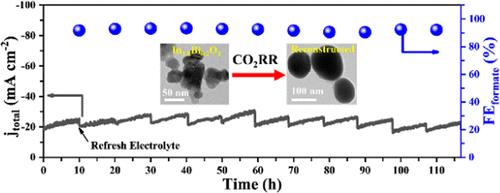当前位置:
X-MOL 学术
›
ACS Catal.
›
论文详情
Our official English website, www.x-mol.net, welcomes your
feedback! (Note: you will need to create a separate account there.)
Surface-Reconstructed, Mesoporous In1.8Bi0.2O3 Nanocubes as Electrocatalysts for Efficient CO2 Conversion to Formate
ACS Catalysis ( IF 11.3 ) Pub Date : 2024-11-14 , DOI: 10.1021/acscatal.4c05431 Yueqi Feng, Jiaomei Xiao, Yiyi Qiu, Jianlin Huang
ACS Catalysis ( IF 11.3 ) Pub Date : 2024-11-14 , DOI: 10.1021/acscatal.4c05431 Yueqi Feng, Jiaomei Xiao, Yiyi Qiu, Jianlin Huang

|
Precise control and understanding of surface changes in indium (In)-based catalysts during the electrocatalytic CO2 reduction reaction (CO2RR) process are challenging. This study presents a series of surface-reconstructed In2O3–Bi electrocatalysts, created by doping mesoporous In2O3 nanocubes with bismuth (Bi). This doping introduces abundant bimetallic In–Bi sites at the crystal–amorphous interfaces, enhancing the CO2-to-formate conversion selectivity. Bi atoms accelerate the surface reconstruction of In2O3, reduce the charge density around In atoms, and promote partial amorphization. In situ X-ray diffraction (XRD) and Fourier-transform infrared spectroscopy (FT-IR) measurements and density functional theory (DFT) calculations show that the bimetallic In–Bi sites lower the energy barrier for the HCOOH* intermediate, enhance H2O dissociation, and inhibit the hydrogen evolution reaction (HER). The surface-reconstructed In1.8Bi0.2O3 electrocatalyst demonstrates a Faradaic efficiency (FE) of 92.6% and a partial current density of −28.5 mA·cm–2 and operates stably for 110 h in a H-type cell. In a flow cell, it achieves an FE of formate (FEformate) of 97.6% at −1.4 VRHE and maintains above 94% FEformate over a potential window of 800 mV (from −1.0 to −1.8 V vs RHE). This study offers an effective approach for designing high-performance electrocatalysts for the CO2RR based on surface reconstruction.
中文翻译:

表面重构的介孔 In1.8Bi0.2O3 纳米立方体作为电催化剂,将 CO2 高效转化为甲酸盐
在电催化 CO2 还原反应 (CO2RR) 过程中,精确控制和了解铟 (In) 基催化剂的表面变化具有挑战性。本研究提出了一系列表面重构的 In2O3-Bi 电催化剂,这些催化剂是通过用铋 (Bi) 掺杂介孔 In2O3 纳米立方体制成的。这种掺杂在晶体-非晶界面处引入了丰富的双金属 In-Bi 位点,增强了 CO2 到甲酸盐的转化选择性。Bi 原子加速 In2O3 的表面重构,降低 In 原子周围的电荷密度,促进部分非晶化。原位X 射线衍射 (XRD) 和傅里叶变换红外光谱 (FT-IR) 测量和密度泛函理论 (DFT) 计算表明,双金属 In-Bi 位点降低了 HCOOH* 中间体的能垒,增强了 H2O 解离,并抑制了析氢反应 (HER)。表面重构的 In1.8Bi0.2O3 电催化剂表现出 92.6% 的法拉第效率 (FE) 和 −28.5 mA·cm–2 的部分电流密度,并在 H 型电池中稳定运行 110 h。在流通池中,它在 −1.4 VRHE 下实现了 97.6% 的甲酸盐 FE(甲酸盐 FE),并在 800 mV 的电位窗口(从 -1.0 到 −1.8 V 与 RHE 之间)保持 94% 以上的甲酸盐 FE。本研究为基于表面重构的 CO2RR 高性能电催化剂设计提供了一种有效的方法。
更新日期:2024-11-14
中文翻译:

表面重构的介孔 In1.8Bi0.2O3 纳米立方体作为电催化剂,将 CO2 高效转化为甲酸盐
在电催化 CO2 还原反应 (CO2RR) 过程中,精确控制和了解铟 (In) 基催化剂的表面变化具有挑战性。本研究提出了一系列表面重构的 In2O3-Bi 电催化剂,这些催化剂是通过用铋 (Bi) 掺杂介孔 In2O3 纳米立方体制成的。这种掺杂在晶体-非晶界面处引入了丰富的双金属 In-Bi 位点,增强了 CO2 到甲酸盐的转化选择性。Bi 原子加速 In2O3 的表面重构,降低 In 原子周围的电荷密度,促进部分非晶化。原位X 射线衍射 (XRD) 和傅里叶变换红外光谱 (FT-IR) 测量和密度泛函理论 (DFT) 计算表明,双金属 In-Bi 位点降低了 HCOOH* 中间体的能垒,增强了 H2O 解离,并抑制了析氢反应 (HER)。表面重构的 In1.8Bi0.2O3 电催化剂表现出 92.6% 的法拉第效率 (FE) 和 −28.5 mA·cm–2 的部分电流密度,并在 H 型电池中稳定运行 110 h。在流通池中,它在 −1.4 VRHE 下实现了 97.6% 的甲酸盐 FE(甲酸盐 FE),并在 800 mV 的电位窗口(从 -1.0 到 −1.8 V 与 RHE 之间)保持 94% 以上的甲酸盐 FE。本研究为基于表面重构的 CO2RR 高性能电催化剂设计提供了一种有效的方法。


















































 京公网安备 11010802027423号
京公网安备 11010802027423号